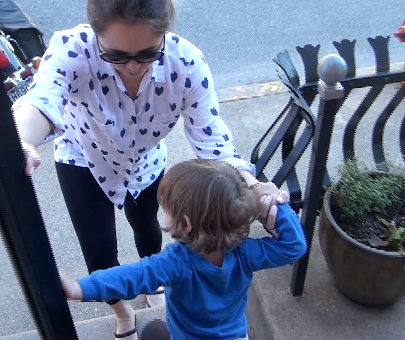
If it feels like you spend all day butting heads with your toddler, this can be exhausting and frustrating for both of you! There are two strategies that are pretty efficient in helping with this constant frustration- create safe spaces, and redirect attention. Creating safe spaces will decrease the need for you to be constantly supervising your toddler, and by redirecting his attention, you will entice him away from dangerous situations. It is important to remember that physical and emotional safety go hand-in-hand. By keeping your toddler physically safe and providing them with a little bit of freedom, you are bolstering his physical and emotional security.
Create safe spaces with baby gates, outlet covers, securing shelves/heavy items to walls, using childproof locks, and providing age appropriate toys within your toddler’s reach.
Be prepared to redirect his attention at any given time. Always have a coveted toy, a healthy snack, and cup of water ready. When he wants something he can’t have, offer up the tricks you have hidden for just such an occasion. Keep some new toys or activities hidden away at home or in your purse so you can pull them out in an emergency. Look around when you go to a new place for things that will interest your child so that when they begin to act out in a restaurant, you can say “hey, look, there is a choo-choo track over there. Let’s see if we can find the train.”
First make sure your toddler is well-rested and well-fed and then consider how you can always provide safe spaces and re-direct his attention in every situation. Try to be more creative than handing over your smartphone or tablet if possible because new learning occurs more from new and novel experiences.
References:
Meltzoff, A. N., & Kuhl, P. K. (2016). Exploring the infant social brain: What’s going on in there? ZERO TO THREE, 36(3), 2–9.
National Scientific Council on the Developing Child. (2011). Children’s emotional development is built into the architecture
of their brains: Working paper no. 2 (Updated ed.). Retrieved from http://developingchild.harvard.edu/wp-content/ uploads/2004/04/Childrens-Emotional-Development-Is-Built-into-the-Architecture-of-Their-Brains.pdf (Original work published 2004)
Cohen, J., Onunaku, N., Clothier, S., & Poppe, J. (2005). Helping young children succeed: Strategies to promote early childhood social and emotional development. Washington, DC: National Conference of State Legislatures and ZERO TO THREE.
Cummings, E. M., & Davies, P. T. (2010). Marital conflict and children: An emotional security perspective. New York, NY: Guilford Press.

